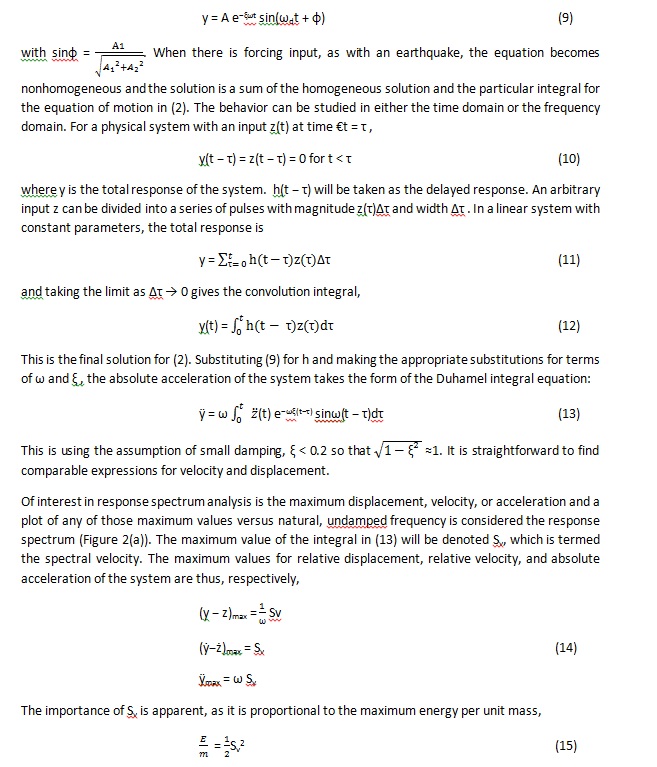Response spectrum analysis is a technique in which we calculate how a given structure will behave to complicated ground motions. It is a method to estimate the structural response to short, nondeterministic, transient dynamic events such as earthquakes. The mass and stiffness distributions of the structure determine its reaction. Stiff buildings, for example, will have moderate accelerations as compared to the ground. Tall buildings have a tendency to accelerate away from ground motions, resulting in low absolute accelerations (the sum of the building’s movement relative to the ground and the ground acceleration). Twisting can be caused by inhomogeneity within the structure.
After the 1908 Reggio Calabria earthquake, which killed over 100,000 lives when combined with a tsunami, Italian engineers began addressing the subject of earthquake response in structural design. They used a static approach, and Danusso advised in 1909 that buildings should “follow docile the shaking action, not opposing it stiffly.” He represented building response as the superposition of n pendulums using acoustic theory. However, his work was not well-known.
The response spectrum method (RSM) was first introduced in Maurice Anthony Biot’s doctoral dissertation at Caltech in 1932. It’s a method for determining a structure’s earthquake response by using waves of vibrational mode forms. Rayleigh’s acoustic ideas were heavily influenced by the mathematical concepts of oscillations in n-degree-of-freedom systems. “…[a] building…has a particular number of so-called normal modes of vibration, each of which corresponds to a given frequency,” Biot said. Biot used the Fourier amplitude spectrum to calculate a system’s maximum amplitude of motion: the summation of the amplitudes for each individual mode of oscillation. In the mid-twentieth century, the concept of the “response spectrum” was used in design criteria, such as in California’s building standards. When strong-motion accelerograph data became readily available in the 1970s, it became widely used as the principal theoretical tool in earthquake engineering.
Earthquake acceleration data can be applied to a mathematical model of a building, for example, with provided masses, stiffness values, and dimensions for each story, to evaluate how the given structure behaves. The linear superposition of single-degree-of-freedom systems for varied mode shapes and natural frequencies is used to depict system response.
Derivation of Response Spectrum Analysis:
The system used for analysis consists of a mass, m, spring with constant k, and dashpot with viscous damping constant, c (with units of force x time per length) (Figure 1).

The system responds to a ground displacement z(t) with absolute displacement y(t). Given the ground motion, or input, the response of the system can be determined using Newton’s second law:


and because relative displacement, given in (14), is proportional to the strains within a system. The easiest measurement to make in a moving structure is its absolute acceleration so the calculated maximum acceleration of the system, also given in (14), can be compared with empirical results. For design purposes, an envelope of spectra for varying earthquakes is determined.

Given a ground acceleration or ground motion record, the integral in (13) must be evaluated for various values of ω and ξ. However, for design purposes, the calculation of the Duhamel integral is not always necessary. Often, the spectral response for a range of periods is available for a local historical earthquake or, based on the seismic history of an area, an acceleration spectrum envelope is developed for use in structural design. Figure 2(b) shows the acceleration response spectra calculated for the El Centro 1940 earthquake for various damping values.
The response spectrum is based on simplified assumptions, although it can provide useful information such as the impacts of different damping levels (though this can be a difficult parameter to determine). Furthermore, because the maximum response values are represented, response spectrum analysis errs on the side of caution. Calculation of the response spectrum is used in ever more complicated assessments of dynamic responses. When compared to the static analysis example described here, frequency domain response analysis preserves phase information.
For a particular site and damage limit, seismic design is normally predicated on a moderate-sized earthquake. Because earthquake motions are unpredictable and reliant on factors like local soil conditions and distance from the source, it’s best to create a smooth envelope of spectra for a range of possible earthquakes in a location. Without evaluating the Duhamel Integral, structural response to a variety of earthquakes may be simply studied. The USGS generates spectrum response maps for damped oscillators subjected to earthquakes with magnitudes greater than 5.5 for T = 0.3, 1.0, and 3.0 seconds as part of its ShakeMap program. This is how the Uniform Building Code (UBC) defines a building code’s “design spectra.” Engineers use the envelope spectra from codes like the UBC and Euro code 8 to build structures.
Of course, the ultimate purpose of employing a technique like response spectrum analysis is to create devices that actively or passively absorb seismic energy. Seismic isolation, for example, entails mounting a structure on bearings with low horizontal rigidity, which raises the natural vibration frequency and reduces acceleration. It was being argued at the time of Biot’s Ph.D. defense whether a building should be inflexible or move with ground vibrations. It is now well acknowledged that ductility – the capacity to move beyond the elastic limit without brittle failure (such as buckling or shearing) – is essential for resilience development.
Response spectrum analysis provides crucial information for real-world applications when evaluating a linear, elastic system that oscillates in response to a forcing function, and it has remained the primary tool in engineering seismology despite several underlying assumptions. More thorough analyses that address temporal modal interactions via superposition have become possible thanks to increases in computer capacity. Even methods for evaluating systems after they enter the nonlinear regime are being developed. Such complicated studies may become more common in building regulations and structural design in the future, although even these assessments rely on reaction spectrum theory.
